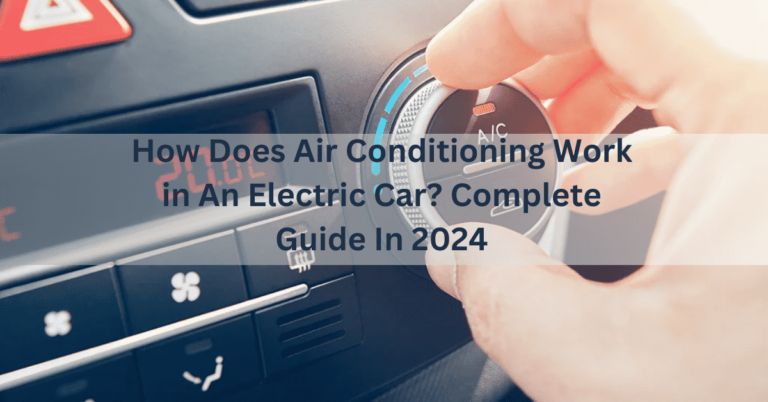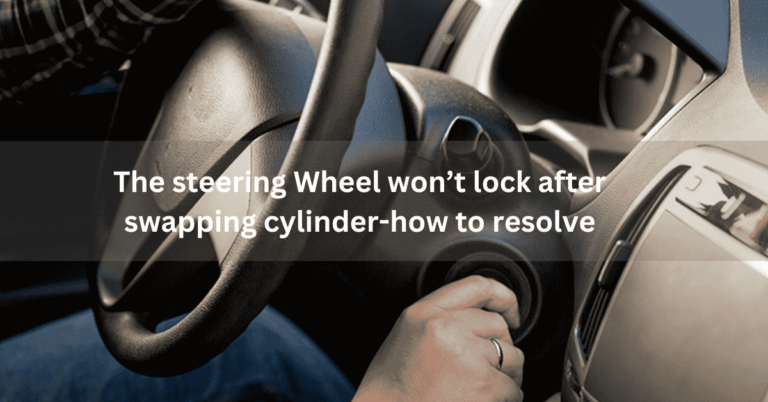I went through a puddle and my car died-what should i do 2024
Have you ever driven through a puddle and had your car stall out? It can be a scary experience!
If you’re worried about it, I went through a puddle and my car died. If water gets into your car’s engine, don’t worry!
In this blog, we’ll answer your questions about what happens when water gets into your engine.
how to tell if you have water in there, and what to do if your car stalls after driving through a puddle.
So, let’s get started!
I went through a puddle and my car died
When driving in rainy conditions, being mindful of the road is essential.
One of the problems of driving in the rain is facing large puddles of standing water on the road.
If your car stalls or dies after driving through a puddle, it is important to assess the situation.
Water can cause serious damage to the engine if it is sucked in through the air intake system. So it’s best to take precautions before starting the car again.
The first step is to open the hood and check the air filter. If the filter is wet, it must be replaced before attempting to restart the engine.
If the filter is dry, waiting for a few hours is still recommended to allow the water to evaporate.
Once you’ve checked the air filter and waited for some time, try starting the engine again.
If it still won’t start, there may be water in the engine, which will require professional attention.
In this case, it’s best to have your car towed to a mechanic who can diagnose and repair any damage caused by water.
Overall, driving through standing water can be dangerous and cause damage to your car’s engine.
Being cautious is important to prevent damage and can save you time and money in the long run.

Also Read
Experiencing A Sharp Steering Wheel Jerk After Stops? Effective Solution
How Can A Driver Know He Has Turned The Steering Wheel To The Correct Angle?
What Happens if Water Gets Into Your Air Filter?
When water gets into your air filter, it can have serious consequences for your engine. The air filter is designed to prevent waste and contaminants from entering the engine.
But when water enters, it can cause several problems.
Here are some outcomes:
1. Reduced airflow:
Water in the air filter can restrict the flow of air to the engine. It can lead to a decrease in performance.
The engine will struggle to breathe, which can cause problems with acceleration. The fuel efficiency and overall power will also affected.
2. Engine damage:
If water gets past the air filter and into the engine. It can mix with the oil and cause damage to the internal components.
Water can cause corrosion, rusting, and other forms of damage that can lead to costly repairs.
3. Hydrolock:
In some cases, water can enter the engine through the air filter and cause hydrolock. when the engine is unable to turn over due to the presence of water in the cylinders.
This can be a serious problem that requires extensive repairs or even engine replacement.
4. Rust and corrosion:
Water in the air filter can lead to rust and corrosion in the engine. It can cause long-term damage and reduce the lifespan of the engine.
Rust can form on the metal parts, and corrosion can eat away at the engine’s components over time.
To prevent water from entering your air filter, it’s important to avoid driving through deep puddles or standing water.
If you suspect that water has entered your air filter. It’s best to have it checked out by a mechanic as soon as possible to prevent any damage to your engine.
Regular maintenance and inspections can also help catch any issues. Before they become more serious.

What Happens if Water Gets in Your Car’s Engine?
If water gets into your car’s engine, it can cause serious damage and potentially lead to a breakdown.
Water in the engine can cause the pistons to seize, which can result in irreversible damage.
Here are some main points:
1. Check the engine oil:
Water in the engine can cause the oil to become milky and discolored.
Check the oil level and appearance to determine if water has entered the engine.
2. Inspect the transmission fluid:
Check the transmission fluid for signs of water contamination.
Water in the transmission can cause damage to the gears and other components.
3. Examine the air filter and intake:
Water in the air filter can cause the engine to stall or run poorly.
Check the air filter and intake for signs of water damage.
4. Look at all lamps on the car:
Water in the electrical system can cause the lamps to malfunction or not work at all.
Check all lamps on the car to ensure they are functioning properly.
5. Check your electronics:
Water can cause damage to the electrical components of the car, such as the ignition system.
Check all electronics in the car to ensure they are functioning properly.
6. Listen for unusual noises:
Water in the engine can cause unusual noises, such as knocking or grinding.
Listen for any unusual noises when starting or running the engine.
How to Remove Water from the Car Engine?
Remember, prevention is key. Avoid driving through deep water or flooded areas whenever possible.
If you do have to drive through water, make sure to go slow and steady.
Here are steps:
1. Turn off the Engine and Disconnect the Battery
The first step is to turn off the engine and disconnect the battery to prevent electrical damage. This is crucial as water can cause electrical shorts that may lead to engine failure or even a fire.
2. Remove the Spark Plugs and Crank the Engine
Remove the spark plugs and crank the engine for a few seconds to remove any water that may be in the cylinders.
This step will help to push any water out of the engine.
Make sure to remove all the spark plugs and turn the engine over for a few seconds. This will help to ensure that any water is expelled.
3. Use a Wet/Dry Vacuum
Use a wet/dry vacuum to remove any standing water from the engine compartment.
This step is important, as any standing water can cause rust and corrosion.
4. Check the Air Filter
Remove the air filter and check for any water damage. If the air filter is wet, it will need to be replaced.
A wet air filter can restrict the flow of air to the engine, which can cause it to run poorly or even stall.
5. Wipe Down the Engine
Using a clean cloth, wipe down any visible water from the engine and other components. This step will help to prevent water from pooling and causing damage.
6. Have a Professional Mechanic Inspect the Engine
If the water damage is extensive. It’s best to have a professional mechanic inspect the engine to ensure it is safe to drive.

Also Read
Why Does My Car Go Left Side When I Don’t Hold The Steering Wheel?
Why Do Sailing Yachts Have Two Steering Wheels? 7 Reasons
How Much Water Is Too Much To Drive Through?
Driving through water can be risky. It’s best to avoid it when possible.
But if you have to, follow these guidelines:
– Most cars can handle 1-2 inches of water.
– Driving through 6 inches of water might let water into your car.
– Fast-flowing water, even shallow, can make you lose control.
– Don’t drive through water deeper than 4 inches if it’s moving.
– If water reaches your front bumper, it’s too deep.
– It’s safer to find another route or wait for the water to go down.

How to restart the car after stalling in water?
If your car stalls in water, here are the steps you should follow to restart it safely:
1. Turn off the ignition and remove the key to prevent any damage to the engine.
2. Get the car out of the water and onto dry land.
3. Try to start the car again once it’s on dry land.
4. If the water has entered the engine, have it towed to a mechanic for repairs.
5. Remember to never try to start the car while it’s still in the water, as this can cause significant damage to the engine.
How long does it take for a car engine to dry out?
The time it takes for a car engine to dry out varies. It depends on the amount of water that enters the engine and the severity of the damage.
It may take a few hours or even a few days for the engine to dry out completely. If water has entered the engine, it may have caused significant damage.
Thus, it’s best to have a professional mechanic inspect and repair the vehicle before attempting to start the engine.

Frequently asked questions:
1. Why does my car shut off after driving through a puddle?
- Your car might shut off because water got into the engine or electrical parts, causing problems.
- If water gets into places it shouldn’t, like the air intake, it messes with how the engine works.
- Electrical systems might short out if water finds its way into them, leading to a shutdown.
- Essentially, water and cars don’t mix well, especially when it comes to sensitive parts.
2. What should you do immediately after driving through a deep puddle?
- After driving through a deep puddle, drive slowly and safely out of it, then check for damage.
- Slow down and carefully drive out of the puddle to avoid further trouble.
- Once you’re out of the water, pull over safely and assess the situation promptly.
- Taking immediate action can help minimize the impact of driving through the puddle.
3. Will my car be OK after driving through the water?
- The outcome depends on factors like the depth of the water and how fast you were going.
- While some cars might come out unscathed, others could face significant damage.
- It’s crucial to pay attention to any warning signs or unusual behavior from your car.
- Getting your car inspected by a professional can provide peace of mind and prevent future problems.
4. Why is my car losing power after driving through water?
Water can interfere with the engine’s ability to function properly, resulting in power loss.
If water gets into the air intake, it disrupts the engine’s combustion process, causing it to struggle.
5. How long does it take for water damage to affect a car?
- Water damage can happen right away or over time, depending on how bad it is and what gets wet.
- Immediate problems like stalling or power loss may indicate significant water damage.
- However, issues like corrosion and electrical malfunctions may develop gradually.
6. How do you know if your car is damaged after driving through water?
Look for signs like stalling, weird sounds, or electrical problems. After driving through the water, pay attention to how your car behaves.
Conclusion:
Driving through puddles of standing water can be a risky affair. It can cause serious damage to your car’s engine.
Water can enter the engine through various means, including the air filter and the intake system. It can cause serious damage to the engine’s components.
Therefore, it’s crucial to take precautionary measures to avoid driving through deep puddles or standing water.
If you notice any signs of water damage to your engine, it’s best to have it checked out by a mechanic. As soon as possible to prevent any further damage.
By taking care of your car’s engine and being cautious while driving. You can prevent costly repairs and ensure your car’s longevity.
Happy Driving.







